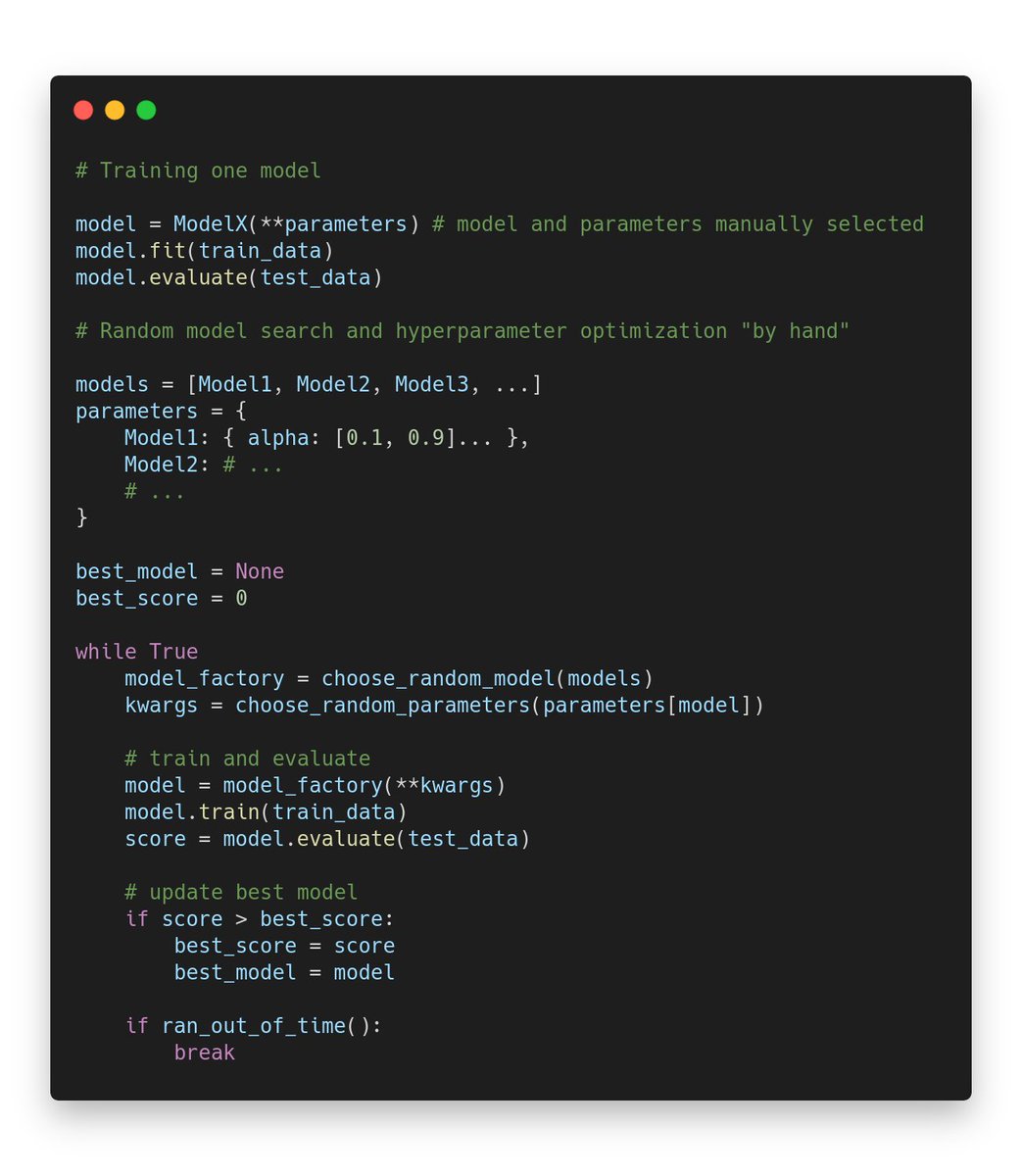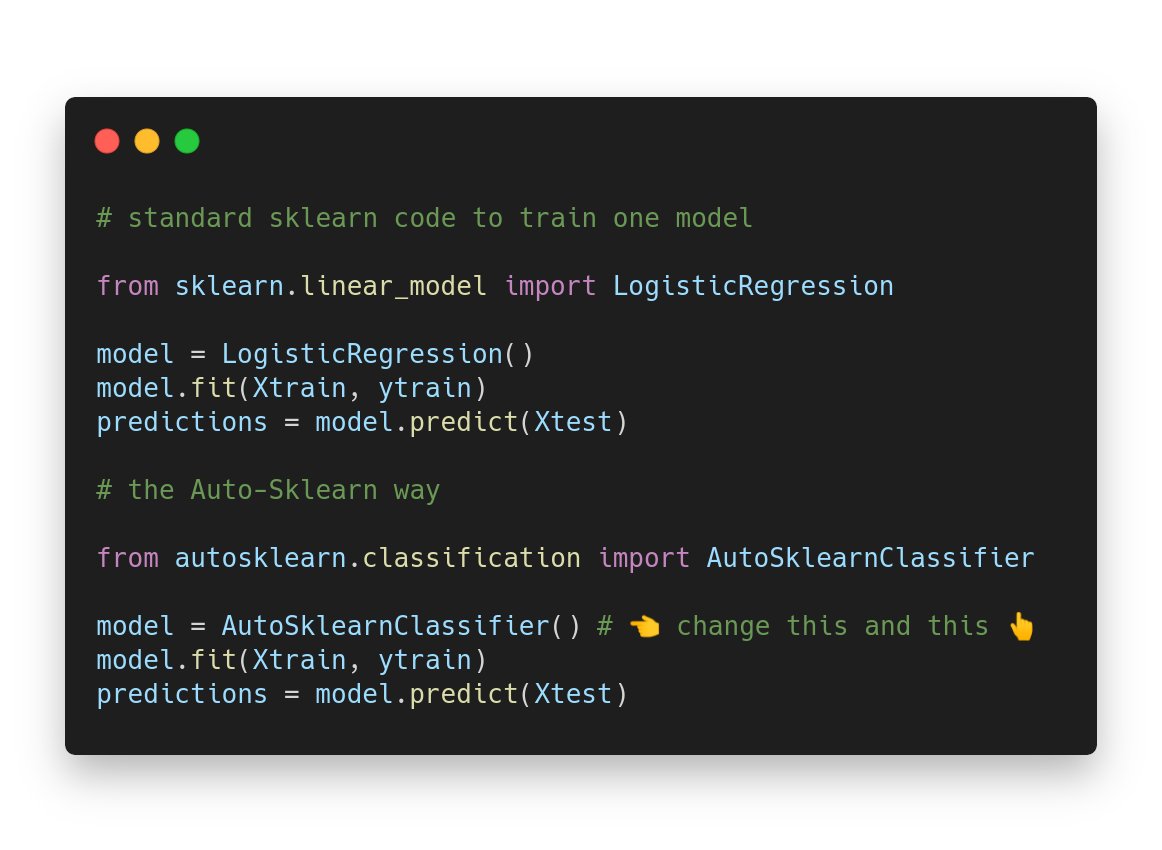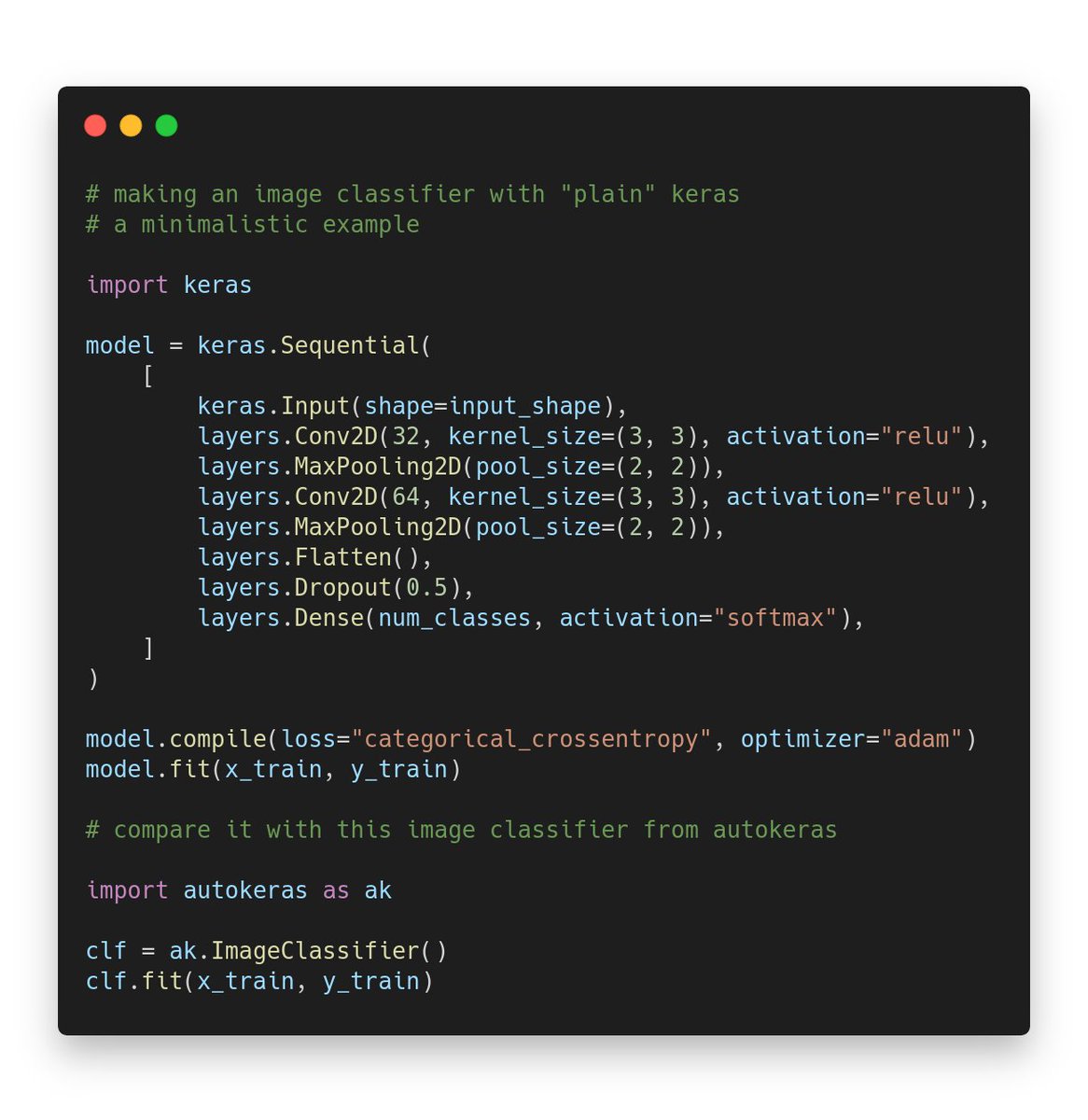Today is #TechnicalTuesday  https://abs.twimg.com/emoji/v2/... draggable="false" alt="🤓" title="Nerd-Gesicht" aria-label="Emoji: Nerd-Gesicht">!
https://abs.twimg.com/emoji/v2/... draggable="false" alt="🤓" title="Nerd-Gesicht" aria-label="Emoji: Nerd-Gesicht">!
Let& #39;s talk about practical technologies that you can use today.
In this thread I will tell you about *AutoML* https://abs.twimg.com/emoji/v2/... draggable="false" alt="🧵" title="Thread" aria-label="Emoji: Thread">
https://abs.twimg.com/emoji/v2/... draggable="false" alt="🧵" title="Thread" aria-label="Emoji: Thread"> https://abs.twimg.com/emoji/v2/... draggable="false" alt="👇" title="Rückhand Zeigefinger nach unten" aria-label="Emoji: Rückhand Zeigefinger nach unten">
https://abs.twimg.com/emoji/v2/... draggable="false" alt="👇" title="Rückhand Zeigefinger nach unten" aria-label="Emoji: Rückhand Zeigefinger nach unten">
Let& #39;s talk about practical technologies that you can use today.
In this thread I will tell you about *AutoML*
AutoML stands for *Automated Machine Learning*.
It encompasses a bunch of technologies and paradigms to gradually automate the process of creating machine learning solutions.
 https://abs.twimg.com/emoji/v2/... draggable="false" alt="💡" title="Elektrische Glühbirne" aria-label="Emoji: Elektrische Glühbirne"> AutoML is about raising the abstraction level in ML and reducing the grunt work.
https://abs.twimg.com/emoji/v2/... draggable="false" alt="💡" title="Elektrische Glühbirne" aria-label="Emoji: Elektrische Glühbirne"> AutoML is about raising the abstraction level in ML and reducing the grunt work.
It encompasses a bunch of technologies and paradigms to gradually automate the process of creating machine learning solutions.
Getting a machine learning solution to work takes a few steps:
-
-
-
-
-
Most current AutoML frameworks today focus on  https://abs.twimg.com/emoji/v2/... draggable="false" alt="3️⃣" title="Tastenkappe Ziffer 3" aria-label="Emoji: Tastenkappe Ziffer 3">, i.e., helping you select among the plethora of machine learning models which is the best for your problem.
https://abs.twimg.com/emoji/v2/... draggable="false" alt="3️⃣" title="Tastenkappe Ziffer 3" aria-label="Emoji: Tastenkappe Ziffer 3">, i.e., helping you select among the plethora of machine learning models which is the best for your problem.
This problem is often framed in terms of:
- https://abs.twimg.com/emoji/v2/... draggable="false" alt="🅰️" title="Invertierter quadratischer lateinischer Buchstabe A" aria-label="Emoji: Invertierter quadratischer lateinischer Buchstabe A"> model selection
https://abs.twimg.com/emoji/v2/... draggable="false" alt="🅰️" title="Invertierter quadratischer lateinischer Buchstabe A" aria-label="Emoji: Invertierter quadratischer lateinischer Buchstabe A"> model selection
- https://abs.twimg.com/emoji/v2/... draggable="false" alt="🅱️" title="Invertierter quadratischer lateinischer Buchstabe B" aria-label="Emoji: Invertierter quadratischer lateinischer Buchstabe B"> hyperparameter optimization
https://abs.twimg.com/emoji/v2/... draggable="false" alt="🅱️" title="Invertierter quadratischer lateinischer Buchstabe B" aria-label="Emoji: Invertierter quadratischer lateinischer Buchstabe B"> hyperparameter optimization
This problem is often framed in terms of:
-
-
The "manual" way of doing this is to actually try each algorithm a bunch of times in your data and collect some statistics.
- How many neurons?
- How much dropout?
- Which activation function?
- Which regularization factor?
- ...
If you combine both problems, then you realize there are literally thousands (and potentially infinite) different algorithms you can try on your data.
If you were to do this yourself, the simplest solution is something like this:
If you were to do this yourself, the simplest solution is something like this:
Let& #39;s see a couple of examples
You">https://automl.github.io/auto-skle... can basically replace standard scikit-learn code with a generic Auto-Sklearn classifier and suddenly you are evaluating thousands of models:
Instead">https://autokeras.com/">... of manually designing a neural network, you can use Auto-Keras predefined "meta-models" and it will take care of finding the best architecture:
Yeah, I know  https://abs.twimg.com/emoji/v2/... draggable="false" alt="🤯" title="Explodierender Kopf" aria-label="Emoji: Explodierender Kopf">!
https://abs.twimg.com/emoji/v2/... draggable="false" alt="🤯" title="Explodierender Kopf" aria-label="Emoji: Explodierender Kopf">!
And AutoML is much more than model selection and hyperparameter search. It can also include automating:
- data preprocessing
- feature engineering
- feature selection
- dataset augmentation
- model distillation
- and more...
And AutoML is much more than model selection and hyperparameter search. It can also include automating:
- data preprocessing
- feature engineering
- feature selection
- dataset augmentation
- model distillation
- and more...
There are a lot of challenges to make AutoML production-ready. Data cleaning is a major bottleneck still, far from automated. And we need to understand how these methods exacerbate data bias.
Finally, if you are feeling adventurous, you can try @auto_goal, an experimental AutoML framework that goes beyond "standard" AutoML.
 https://abs.twimg.com/emoji/v2/... draggable="false" alt="⭐" title="Mittelgroßer Stern" aria-label="Emoji: Mittelgroßer Stern"> Check it out in https://autogoal.github.io"> https://autogoal.github.io !
https://abs.twimg.com/emoji/v2/... draggable="false" alt="⭐" title="Mittelgroßer Stern" aria-label="Emoji: Mittelgroßer Stern"> Check it out in https://autogoal.github.io"> https://autogoal.github.io !
As usual, if you like this topic, reply in this thread or @ me at any time. Feel free to  https://abs.twimg.com/emoji/v2/... draggable="false" alt="❤️" title="Rotes Herz" aria-label="Emoji: Rotes Herz"> like and
https://abs.twimg.com/emoji/v2/... draggable="false" alt="❤️" title="Rotes Herz" aria-label="Emoji: Rotes Herz"> like and  https://abs.twimg.com/emoji/v2/... draggable="false" alt="🔁" title="Nach rechts und links zeigende Pfeile in offenem Kreis im Uhrzeigersinn" aria-label="Emoji: Nach rechts und links zeigende Pfeile in offenem Kreis im Uhrzeigersinn"> retweet if you think someone else could benefit from knowing this stuff.
https://abs.twimg.com/emoji/v2/... draggable="false" alt="🔁" title="Nach rechts und links zeigende Pfeile in offenem Kreis im Uhrzeigersinn" aria-label="Emoji: Nach rechts und links zeigende Pfeile in offenem Kreis im Uhrzeigersinn"> retweet if you think someone else could benefit from knowing this stuff.
 https://abs.twimg.com/emoji/v2/... draggable="false" alt="🧵" title="Thread" aria-label="Emoji: Thread"> Read this thread online at < https://apiad.net/tweetstorms/technicaltuesday-automl>">https://apiad.net/tweetstor...
https://abs.twimg.com/emoji/v2/... draggable="false" alt="🧵" title="Thread" aria-label="Emoji: Thread"> Read this thread online at < https://apiad.net/tweetstorms/technicaltuesday-automl>">https://apiad.net/tweetstor...
Stay curious  https://abs.twimg.com/emoji/v2/... draggable="false" alt="🖖" title="„Live long and prosper!“" aria-label="Emoji: „Live long and prosper!“">
https://abs.twimg.com/emoji/v2/... draggable="false" alt="🖖" title="„Live long and prosper!“" aria-label="Emoji: „Live long and prosper!“">
- https://abs.twimg.com/emoji/v2/... draggable="false" alt="🔗" title="Link Symbol" aria-label="Emoji: Link Symbol"> < https://www.automl.org/automl/ >
https://abs.twimg.com/emoji/v2/... draggable="false" alt="🔗" title="Link Symbol" aria-label="Emoji: Link Symbol"> < https://www.automl.org/automl/ >
-">https://www.automl.org/automl/&q... https://abs.twimg.com/emoji/v2/... draggable="false" alt="📚" title="Bücher" aria-label="Emoji: Bücher"> < https://www.automl.org/book/ >
https://abs.twimg.com/emoji/v2/... draggable="false" alt="📚" title="Bücher" aria-label="Emoji: Bücher"> < https://www.automl.org/book/ >
-">https://www.automl.org/book/&quo... https://abs.twimg.com/emoji/v2/... draggable="false" alt="🎥" title="Filmkamera" aria-label="Emoji: Filmkamera"> < https://youtu.be/3c0FoQrsJxo >
https://abs.twimg.com/emoji/v2/... draggable="false" alt="🎥" title="Filmkamera" aria-label="Emoji: Filmkamera"> < https://youtu.be/3c0FoQrsJxo >
-">https://youtu.be/3c0FoQrsJ... https://abs.twimg.com/emoji/v2/... draggable="false" alt="🎁" title="Verpacktes Geschenk" aria-label="Emoji: Verpacktes Geschenk"> < https://github.com/windmaple/awesome-AutoML>">https://github.com/windmaple...
https://abs.twimg.com/emoji/v2/... draggable="false" alt="🎁" title="Verpacktes Geschenk" aria-label="Emoji: Verpacktes Geschenk"> < https://github.com/windmaple/awesome-AutoML>">https://github.com/windmaple...
-
-">https://www.automl.org/automl/&q...
-">https://www.automl.org/book/&quo...
-">https://youtu.be/3c0FoQrsJ...

 Read on Twitter
Read on Twitter
 Auto-Sklearn is an AutoML framework compatible with scikit-learn.https://abs.twimg.com/emoji/v2/... draggable="false" alt="🔗" title="Link Symbol" aria-label="Emoji: Link Symbol"> < https://automl.github.io/auto-skle... can basically replace standard scikit-learn code with a generic Auto-Sklearn classifier and suddenly you are evaluating thousands of models:" title="https://abs.twimg.com/emoji/v2/... draggable="false" alt="❤️" title="Rotes Herz" aria-label="Emoji: Rotes Herz"> Auto-Sklearn is an AutoML framework compatible with scikit-learn.https://abs.twimg.com/emoji/v2/... draggable="false" alt="🔗" title="Link Symbol" aria-label="Emoji: Link Symbol"> < https://automl.github.io/auto-skle... can basically replace standard scikit-learn code with a generic Auto-Sklearn classifier and suddenly you are evaluating thousands of models:" class="img-responsive" style="max-width:100%;"/>
Auto-Sklearn is an AutoML framework compatible with scikit-learn.https://abs.twimg.com/emoji/v2/... draggable="false" alt="🔗" title="Link Symbol" aria-label="Emoji: Link Symbol"> < https://automl.github.io/auto-skle... can basically replace standard scikit-learn code with a generic Auto-Sklearn classifier and suddenly you are evaluating thousands of models:" title="https://abs.twimg.com/emoji/v2/... draggable="false" alt="❤️" title="Rotes Herz" aria-label="Emoji: Rotes Herz"> Auto-Sklearn is an AutoML framework compatible with scikit-learn.https://abs.twimg.com/emoji/v2/... draggable="false" alt="🔗" title="Link Symbol" aria-label="Emoji: Link Symbol"> < https://automl.github.io/auto-skle... can basically replace standard scikit-learn code with a generic Auto-Sklearn classifier and suddenly you are evaluating thousands of models:" class="img-responsive" style="max-width:100%;"/>
 Auto-Keras is an AutoML framework specifically designed for deep learning with Keras.https://abs.twimg.com/emoji/v2/... draggable="false" alt="🔗" title="Link Symbol" aria-label="Emoji: Link Symbol"> < https://autokeras.com/">... of manually designing a neural network, you can use Auto-Keras predefined "meta-models" and it will take care of finding the best architecture:" title="https://abs.twimg.com/emoji/v2/... draggable="false" alt="❤️" title="Rotes Herz" aria-label="Emoji: Rotes Herz"> Auto-Keras is an AutoML framework specifically designed for deep learning with Keras.https://abs.twimg.com/emoji/v2/... draggable="false" alt="🔗" title="Link Symbol" aria-label="Emoji: Link Symbol"> < https://autokeras.com/">... of manually designing a neural network, you can use Auto-Keras predefined "meta-models" and it will take care of finding the best architecture:" class="img-responsive" style="max-width:100%;"/>
Auto-Keras is an AutoML framework specifically designed for deep learning with Keras.https://abs.twimg.com/emoji/v2/... draggable="false" alt="🔗" title="Link Symbol" aria-label="Emoji: Link Symbol"> < https://autokeras.com/">... of manually designing a neural network, you can use Auto-Keras predefined "meta-models" and it will take care of finding the best architecture:" title="https://abs.twimg.com/emoji/v2/... draggable="false" alt="❤️" title="Rotes Herz" aria-label="Emoji: Rotes Herz"> Auto-Keras is an AutoML framework specifically designed for deep learning with Keras.https://abs.twimg.com/emoji/v2/... draggable="false" alt="🔗" title="Link Symbol" aria-label="Emoji: Link Symbol"> < https://autokeras.com/">... of manually designing a neural network, you can use Auto-Keras predefined "meta-models" and it will take care of finding the best architecture:" class="img-responsive" style="max-width:100%;"/>


